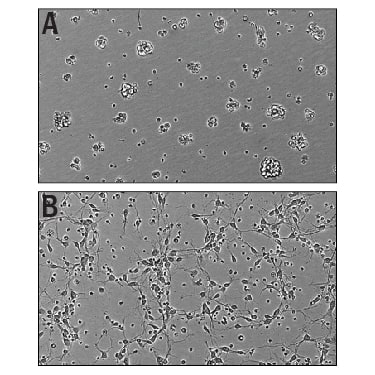Recombinant Mouse Slit3 (aa 34-1116) Protein, CF
R&D Systems, part of Bio-Techne | Catalog # 9296-SL

Key Product Details
Product Specifications
Source
Mouse myeloma cell line, NS0-derived mouse Slit3 protein
Cys34-Val1116, with a C-terminal 6-His tag
Cys34-Val1116, with a C-terminal 6-His tag
Purity
>90%, by SDS-PAGE visualized with Silver Staining and quantitative densitometry by Coomassie® Blue Staining.
Endotoxin Level
<0.10 EU per 1 μg of the protein by the LAL method.
N-terminal Sequence Analysis
Cys34
Predicted Molecular Mass
122 kDa
SDS-PAGE
121-153 kDa, reducing conditions
Activity
Measured by its ability to enhance neurite outgrowth of E16-E18 rat embryonic cortical neurons.
Recombinant Mouse Slit3, immobilized at 2.5-5 μg/mL on a 96-well plate, is able to significantly enhance neurite outgrowth.
Recombinant Mouse Slit3, immobilized at 2.5-5 μg/mL on a 96-well plate, is able to significantly enhance neurite outgrowth.
Scientific Data Images for Recombinant Mouse Slit3 (aa 34-1116) Protein, CF
Recombinant Mouse Slit3 (aa 34-1116) Protein Bioactivity
Recombinant Mouse Slit3 (Catalog # 9296-SL) Induces Cortical Neurite Outgrowth. A) Untreated E16-E18 embryonic rat cortical neurons. B) Neurite outgrowth in E16-E18 embryonic rat cortical neurons treated with 5 μg/ml of Recombinant Mouse Slit3.Formulation, Preparation and Storage
9296-SL
| Formulation | Supplied as a 0.2 μm filtered solution in Sodium Acetate, NaCl and Ethylene Glycol. |
| Shipping | The product is shipped with dry ice or equivalent. Upon receipt, store it immediately at the temperature recommended below. |
| Stability & Storage | Use a manual defrost freezer and avoid repeated freeze-thaw cycles.
|
Background: Slit3
References
- Blockus, H. and A. Chedotal (2014) Curr. Opin Neurobiol. 27:82.
- Gara, R.K. et al. (2015) Drug Discov. Today 20:156.
- Little, M. H. et al. (2001) Am. J. Physiol. Cell Physiol. 281:C486.
- Yuan, W. et al. (1999) Dev. Biol. 212:290.
- Brose, K. et al. (1999) Cell 96:795.
- Long, H. et al. (2004) Neuron 42:213.
- Greenberg, J.M. et al. (2004) Dev. Dyn. 230:350.
- Liu, J. et al. (2003) Mech. Dev. 120:1059.
- Yuan, W. et al. (2003) Proc. Natl. Acad. Sci. USA 100:5217.
- Zhang, B. et al. (2009) Blood 114:4300.
- Geutskens, S.B. et al. (2010) J. Immunol. 185:7691.
- Denk, A.E. et al. (2011) Int. J. Mol. Med. 28:721.
- Zhang, C. et al. (2015) Oncol. Rep. 34:952.
- Delloye-Bourgeois, C. et al. (2015) Nat. Neurosci. 18:36.
- Condac, E. et al. (2012) Glycobiology 22:1183.
Long Name
SLIT Homolog 3
Alternate Names
MEGF5, SLIL2
Gene Symbol
SLIT3
UniProt
Additional Slit3 Products
Product Documents for Recombinant Mouse Slit3 (aa 34-1116) Protein, CF
Product Specific Notices for Recombinant Mouse Slit3 (aa 34-1116) Protein, CF
For research use only
